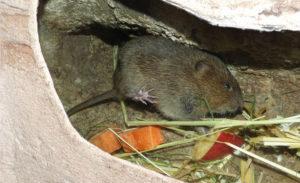How to deal with earth rats in the garden: 7 effective ways
People treat mice and rats differently. Some consider them pests, while others are cute. There are those who acquire ornamental rats and mice as pets. Representatives of the weaker sex prefer not to meet with them personally. Separately in the impromptu hierarchy is the earth rat.
Content
Earth rat in the garden: photo
Name: Water vole, European water rat
Latin: Arvicola amphibiusClass: Mammals - Mammalia
Squad: Rodents - Rodentia
Family: Hamsters - Cricetidae
 | Habitats: | banks along ponds, fields and gardens |
 | Catering: | bark and roots, bulbs, small mammals, insects |
 | Features: | semi-aquatic lifestyle, life in a large colony |
Description of the pest
The earth rat is actually a mouse, a water vole, which is actually a member of the hamster family. This mammal is called a rat for its appearance. It is slightly larger than all its relatives, but smaller than the muskrat, the largest of them.
The water vole has a large body, short muzzle and short legs. The tail can be 2/3 the length of the entire body of the rat, the maximum size of which reaches 25 cm. The coat can vary in shades depending on the region and period, from brownish gray to pure black. There is also a small amount of hair on the tail.
Get to know better water vole can be in the proposed article.
Life Activity
The earth rat has some quality, which you should be aware of. They damage land and even agriculture on a large scale. Water voles breed quickly and are very prolific. They have 5 cubs in each offspring, and they give birth 2-3 times a year.
Pests, although active, are also cunning. For example, they get along well with moles. Earth rats love to use their moves and even steal supplies.

Rats get along with moles.
How to recognize the appearance of rats
Naturally, the first sign of the presence of an earth rat in the garden or on the site is visual. They can be seen in the process of life, live.
But if they were not personally met on the garden plot, but there are symptoms, you need to pay attention to some signs:
- the disappearance of eggs in chickens;
- gnawing tubers, bulbs and bark of young trees;
- trodden underground passages that fail.
The rat swims well, but does not like water in its dwelling. Therefore, it is good to drive them out of the site by filling their underground passages with water.
How to drive out a field rat
As with any pest, it is best to prevent the appearance of intruders. There are several ways to do this.
- Animals. Rats do not settle in the area where there are cats and dogs. Of course, this applies to those pets that are active on the street. A room cat will not help here.
- Ultrasonic repellers. They cost a certain amount, but they work effectively. The sound is not audible to humans, but repels rats, mice and moles. There are different models that differ in range and type of power supply.
- Unpleasant odors. The rodent has a very delicate sense of smell, so unpleasant odors prevent them from living on the site. They won't drive out a large colony, but they will definitely drive out a few animals from the barn.
A proven remedy is Vishnevsky's ointment. Of course, it is noticeably unpleasant for the human scent, but for the sake of business, you can endure.
- Direct contact. The paws of the earth rat are very sensitive. Spruce needles scattered around the perimeter of the site, glass wool, broken glass will be a good obstacle. Wood ash on the skin causes wounds, so it can also be used. Moreover, it is also a good fertilizer.
- Hunters. And this does not mean shooting earth rats. Dogs, especially several hunting breeds and cats, at the sight of a rodent, will immediately turn on their instincts and strangle it or simply kick it out. Often this type of rodent is also called earthen dogs.
- physical contact - traps such as mousetraps, rattraps or glue traps. The first ones work effectively, but they need to be constantly checked. But there is also a risk that pets can fall into the trap. Sticky strips are ineffective for a large animal.
- Chemicals. This method is effective and efficient, but requires caution. Poisons are best decomposed in burrows and underground passages, so that the insect will surely swallow it. However, there are a number of significant downsides. The poison can also be ingested by cats or dogs. But there is another important point - chemicals remain in the soil for a long time and can get into plants.
Conclusion
Earth rats are a real disaster for farmers and gardeners. She can quickly trample the site and harm the plantings. Everyone chooses the method of getting rid of pests that he likes, from harmless repelling to radical destruction.

